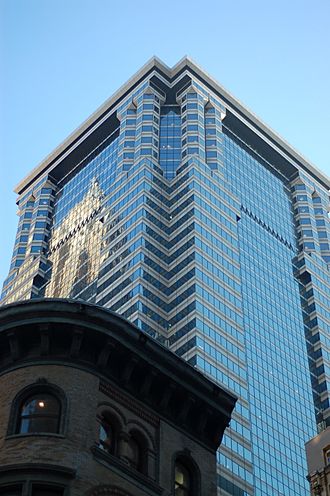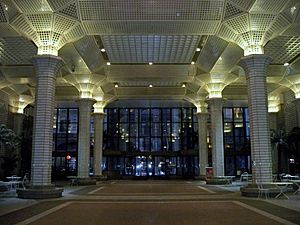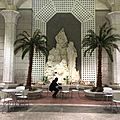60 Wall Street facts for kids
Quick facts for kids 60 Wall Street |
|
|---|---|
 |
|
| General information | |
| Status | Complete |
| Architectural style | Postmodernism |
| Location | 60 Wall Street New York City, New York 10005 United States |
| Completed | 1989 |
| Owner | GIC Singapore (95%) |
| Height | |
| Antenna spire | 745 ft (227 m) |
| Technical details | |
| Floor count | 50 |
| Floor area | 1,700,698 sq ft (158,000.0 m2) |
| Design and construction | |
| Architect | Kevin Roche John Dinkeloo & Associates |
| Structural engineer | WSP Cantor Seinuk |
60 Wall Street is a tall skyscraper in New York City. It stands 745-foot-tall (227 m) and has 47 stories. You can find it on Wall Street in the Financial District of Lower Manhattan. The building was designed by Kevin Roche, John Dinkeloo & Associates. It has a special look that mixes postmodern, Greek revival, and neoclassical styles. This design helps show off its impressive height and size.
The land where 60 Wall Street now stands used to have several other buildings. The Bank of New York first planned a large office tower here. But their plans were canceled. Later, in 1983, a company called Park Tower Realty bought the land. They planned an even bigger 60-story office tower. In 1985, J.P. Morgan & Co. decided to buy and use the whole building. The project was finished in 1989. Since 2001, the building has been the main office for Deutsche Bank in America. Deutsche Bank plans to move out in 2021.
Contents
Building History
Early Plans and JPMorgan's Role
The area where 60 Wall Street is built today was once home to many different buildings. These included several office buildings of various heights. For example, there was a 12-story building at 70 Wall Street and a 27-story building that was the main office for Cities Service. Most of these older buildings were taken down in 1974. This happened after the oil company Cities Service moved its main office to Oklahoma.
After buying the land, the Bank of New York wanted to build a large office tower. However, their plans were stopped. This was because some local leaders protested. They did not want the bank to get a big tax break from the city. By 1983, the land was sold to Park Tower Realty Company. They planned to build a 60-story office tower.
Park Tower Realty also bought extra building space from a nearby landmark building, 55 Wall Street. This extra space is called "air rights." It allowed them to build a larger tower. The project also got bonuses for including public spaces. These included a covered walkway and arcade areas on Wall and Pine Streets. The developers hoped to start building in 1984 and finish by 1986.
The New York City Landmarks Preservation Commission had to approve changes to the landmark 55 Wall Street. In 1984, they approved the transfer of air rights to the 60 Wall Street site. A local community board also approved the project. However, by early 1985, the land was still empty. The developers blamed delays on the city's building permit process.
In September 1985, J.P. Morgan & Co. announced they would buy and use the entire new tower. This was a big deal because JPMorgan had thought about moving its main office to another state. In 1988, JPMorgan received a large loan to help pay for the project. The building was completed in 1989.
Deutsche Bank Takes Over
In 2000, JPMorgan merged with Chase Manhattan Bank. The new company, JPMorgan Chase, decided to move its offices. They left 60 Wall Street. In 2001, Deutsche Bank bought 60 Wall Street for $600 million. At first, Deutsche Bank was not sure what to do with the building.
However, after the September 11 attacks, Deutsche Bank's other building was damaged. So, about 5,500 of their employees moved into 60 Wall Street. In 2007, Deutsche Bank sold the building. They then leased it back for 15 years, until 2022. This meant they still used the building but no longer owned it.
In 2016, Deutsche Bank started to update the building's offices. They wanted to create more open and teamwork-friendly spaces. In 2017, a company from Singapore, GIC, bought 95% of the building. This valued the tower at $1.1 billion. In 2018, Deutsche Bank announced they would move out of 60 Wall Street. They plan to move to a smaller office in the Time Warner Center. This means 60 Wall Street will be empty starting in late 2021.
In 2019, Deutsche Bank removed a famous artwork from the lobby. It was a large painting by German artist Gerhard Richter. The bank replaced it with art from younger artists.
Building Features
The design of 60 Wall Street helps it fit in with the older, slender skyscrapers around it. These include 70 Pine Street and 20 Exchange Place. The building makes a strong impression on the Lower Manhattan skyline.
The lobby of 60 Wall Street has a special entrance. It leads directly to the Wall Street subway station. This entrance is open only on weekdays.
60 Wall Street was also a well-known spot during the Occupy Wall Street protests. These protests happened in nearby Zuccotti Park in 2011. Some news reports even called 60 Wall Street the "Real Headquarters of OWS." This was because the building's public atrium hosted many meetings for the activists.
In 2012, Deutsche Bank added a large solar panel system to the roof of the building. This system helps reduce carbon pollution by 100 metric tons each year. It is the biggest solar panel setup in Manhattan. At 737 feet (225 m) above the ground, it is also one of the highest solar panel arrays in the world.
Images for kids
See also
 In Spanish: 60 Wall Street para niños
In Spanish: 60 Wall Street para niños






